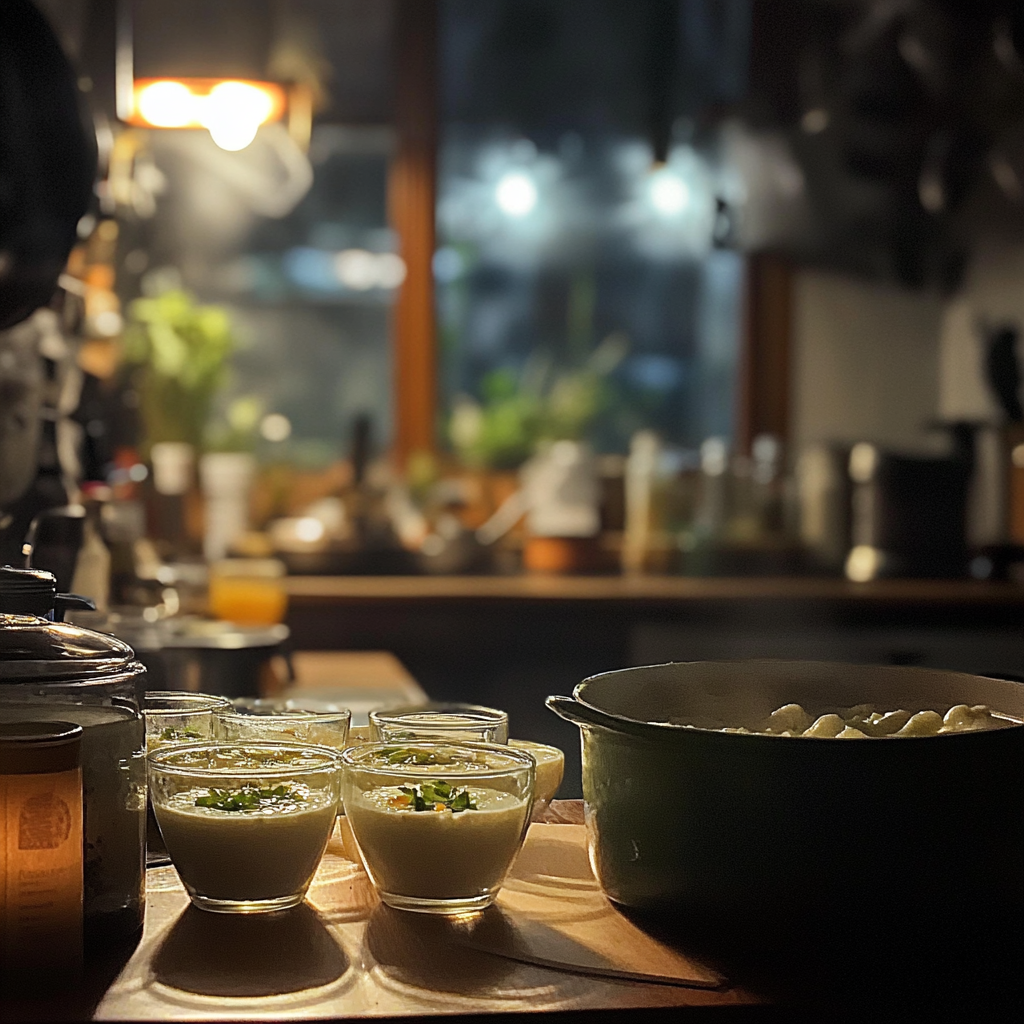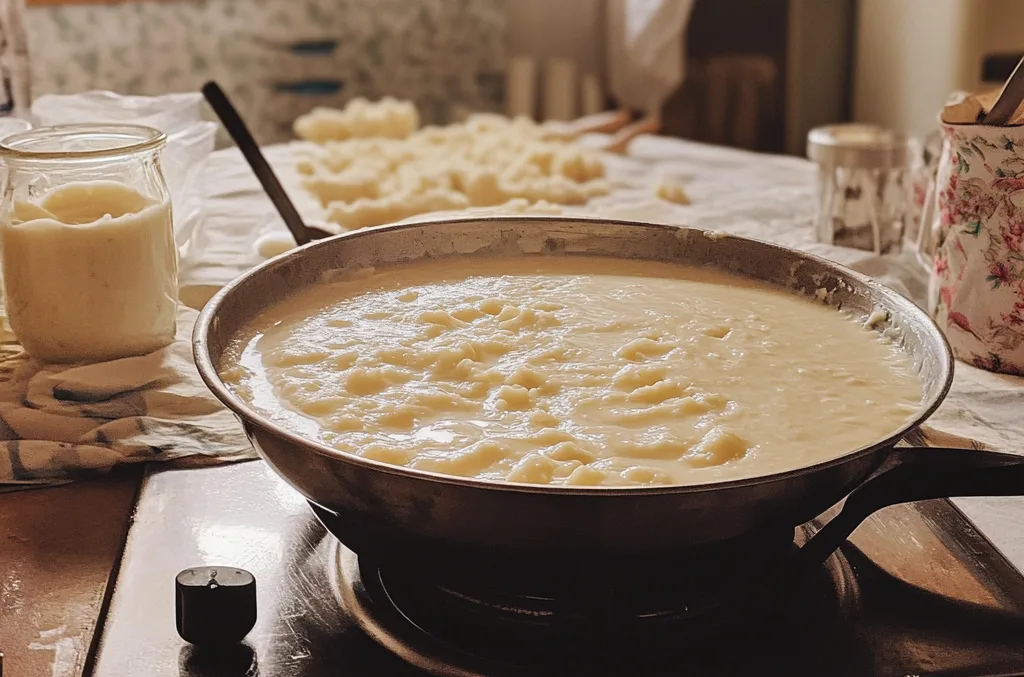Making yogurt at home is a rewarding process that allows you to enjoy fresh, healthy, and customizable yogurt at any time. You don’t need fancy equipment or specialized ingredients—just a bit of time and patience. In this article, we’ll break down everything you need to know about making yogurt in your kitchen, from essential ingredients to troubleshooting tips.
Outline:
- Introduction to Homemade Yogurt
- Why Make Yogurt at Home?
- Health Benefits of Homemade Yogurt
- Cost-Effectiveness of Homemade Yogurt
- What You’ll Need
- Essential Ingredients
- Necessary Equipment
- Types of Yogurt You Can Make
- Plain Yogurt
- Greek Yogurt
- Vegan Yogurt
- Step-by-Step Process for Making Yogurt
- Preparing the Milk
- Heating the Milk
- Cooling the Milk
- Adding Yogurt Starter
- Incubation Process
- Refrigerating the Yogurt
- How Long Does It Take to Make Yogurt?
- Tips for Achieving the Perfect Yogurt Texture
- Choosing the Right Milk
- Adjusting the Incubation Time
- How to Make Thick, Creamy Yogurt
- How to Flavor Your Homemade Yogurt
- Sweeteners
- Fruit Add-ins
- Herbs and Spices
- How to Store Homemade Yogurt
- Common Mistakes and How to Avoid Them
- Yogurt Not Setting Properly
- Yogurt Too Runny
- Grainy or Lumpy Texture
- Troubleshooting Yogurt Issues
- Health Benefits of Homemade Yogurt
- Probiotics
- Nutrient Content
- Yogurt Recipes to Try at Home
- Frequently Asked Questions
- Conclusion
Introduction to Homemade Yogurt
If you’ve ever wondered how to make yogurt at home, you’re in the right place. Homemade yogurt is simpler than it sounds and can be customized to your taste and texture preferences. Whether you want to make regular yogurt, thick Greek-style yogurt, or even vegan yogurt, the process remains similar and incredibly rewarding. In this guide, we’ll explore how you can whip up a batch of yogurt in your kitchen, saving you money while giving you full control over the ingredients.
Why Make Yogurt at Home?
Health Benefits of Homemade Yogurt
Homemade yogurt has several health advantages over store-bought varieties. First, it contains fewer additives and preservatives. You control the ingredients, which means no unnecessary sugars or artificial flavors. Plus, homemade yogurt is rich in probiotics—beneficial bacteria that support digestion and gut health.
Cost-Effectiveness of Homemade Yogurt
Store-bought yogurt can be expensive, especially if you prefer high-quality, organic brands. Making yogurt at home is cost-effective. For the price of a gallon of milk, you can make a large batch of yogurt, which is much cheaper than buying individual containers.
What You’ll Need
Essential Ingredients
- Milk: Whole milk, 2%, or skim milk will work. For Greek yogurt, whole milk is recommended for a creamier texture.
- Yogurt Starter: You’ll need a bit of yogurt with live cultures to start your batch. Store-bought plain yogurt works, or you can use a commercial starter culture.
Necessary Equipment
- A saucepan for heating the milk
- A thermometer to check temperatures
- A whisk to mix the yogurt starter
- A glass or ceramic container to incubate the yogurt
- An incubation environment such as a warm oven, yogurt maker, or insulated cooler
Types of Yogurt You Can Make
Plain Yogurt
This is the simplest form of yogurt—just milk and a yogurt starter. It’s lightly tangy and can be used as a base for all kinds of dishes, from smoothies to salad dressings.
Greek Yogurt
Greek yogurt is simply plain yogurt that has been strained to remove excess whey, giving it a thicker consistency and higher protein content. It’s perfect for creamy dips or a healthy snack.
Vegan Yogurt
If you’re avoiding dairy, you can make yogurt from plant-based milks like almond, coconut, or soy milk. You’ll need a vegan yogurt starter, as these cultures differ from those in dairy yogurt.
Step-by-Step Process for Making Yogurt
1. Preparing the Milk
Start by choosing your milk. Whole milk results in a creamier yogurt, but you can use low-fat or non-fat milk as well.
2. Heating the Milk
Pour the milk into a saucepan and heat it over medium heat until it reaches about 180°F (82°C). This step helps to kill any unwanted bacteria and prepares the milk proteins for culturing.
3. Cooling the Milk
After heating, remove the milk from heat and let it cool to around 110°F (43°C). This is the ideal temperature for adding your yogurt starter without killing the live cultures.
4. Adding the Yogurt Starter
Once the milk has cooled, whisk in your yogurt starter (about 2 tablespoons of yogurt per quart of milk). Make sure it’s well-mixed.
5. Incubation Process
Transfer the mixture to a glass or ceramic container and keep it warm for 4-12 hours. You can use a yogurt maker, a warm oven (set to around 100°F or the oven light), or wrap the container in a towel and place it in an insulated cooler.
6. Refrigerating the Yogurt
After the incubation period, transfer the yogurt to the fridge and let it chill for at least 2 hours before eating. This helps it firm up and enhances the flavor.
How Long Does It Take to Make Yogurt?
The entire process from start to finish takes about 8-12 hours. While the hands-on time is minimal, you’ll need to plan ahead for the incubation and chilling stages.
Tips for Achieving the Perfect Yogurt Texture
Choosing the Right Milk
Full-fat milk produces a thicker, creamier yogurt. If you’re using low-fat milk, you can add powdered milk or gelatin to achieve a similar consistency.
Adjusting the Incubation Time
Longer incubation times result in tangier yogurt. If you prefer a mild flavor, keep the incubation time closer to 4 hours. For a more tart yogurt, go for 8-12 hours.
How to Make Thick, Creamy Yogurt
If you love thick yogurt, try straining the yogurt in a cheesecloth or fine mesh sieve after the incubation process. This removes excess whey and creates a texture similar to Greek yogurt.
How to Flavor Your Homemade Yogurt

Sweeteners
You can sweeten your yogurt with honey, maple syrup, or sugar. Add these after the yogurt has incubated and chilled for best results.
Fruit Add-ins
Stir in fresh or cooked fruit like berries, peaches, or bananas to add natural sweetness. You can also use fruit compotes for a more intense flavor.
Herbs and Spices
For a savory twist, mix in herbs like mint, cilantro, or dill, or add spices such as cinnamon or nutmeg.
How to Store Homemade Yogurt
Homemade yogurt should be stored in the refrigerator and will stay fresh for up to 2 weeks. Make sure to keep it in an airtight container to preserve its texture and flavor.
Common Mistakes and How to Avoid Them
Yogurt Not Setting Properly
This often happens when the incubation temperature is too low or the yogurt starter isn’t fresh. Make sure the milk is cooled to the right temperature before adding the starter, and keep the incubation environment warm.
Yogurt Too Runny
If your yogurt is too runny, it could be due to insufficient incubation time. Try letting it incubate for a bit longer or straining it after incubation to remove extra liquid.
Grainy or Lumpy Texture
Grainy yogurt is often caused by adding the starter when the milk is too hot. Make sure to let the milk cool properly before mixing in the starter.
Troubleshooting Yogurt Issues
If you run into problems, don’t worry! Homemade yogurt can be finicky, but with a little practice, you’ll figure out what works best for you. If your yogurt isn’t thickening, try adjusting the milk type or the incubation environment.
Health Benefits of Homemade Yogurt
Probiotics
Homemade yogurt is packed with probiotics that support healthy digestion and immune function. These live cultures help maintain a healthy gut microbiome.
Nutrient Content
Yogurt is rich in calcium, protein, and vitamins like B12. When you make it at home, you ensure that no unnecessary additives compromise the nutritional value.
Yogurt Recipes to Try at Home
- Greek Yogurt Parfait: Layer yogurt with granola, fresh fruit, and a drizzle of honey.
- Tzatziki Sauce: Combine yogurt with cucumbers, garlic, and dill for a tangy dip.
- Frozen Yogurt Bark: Spread yogurt on a baking sheet, top with fruit and nuts, and freeze for a delicious snack.
Conclusion
Making yogurt at home is not only fun but also gives you the freedom to customize flavors and textures while ensuring a nutritious and wholesome product. Whether you want to save money, avoid artificial ingredients, or just enjoy the satisfaction of making something from
